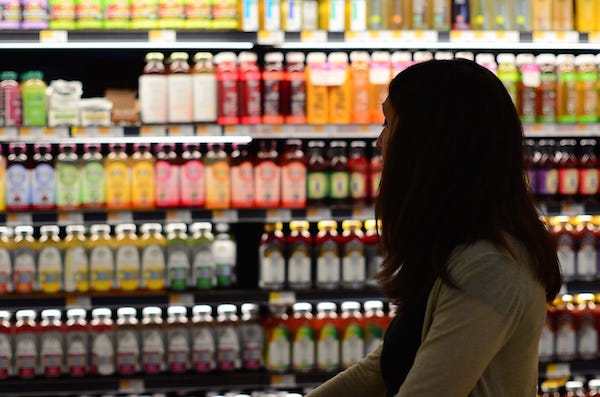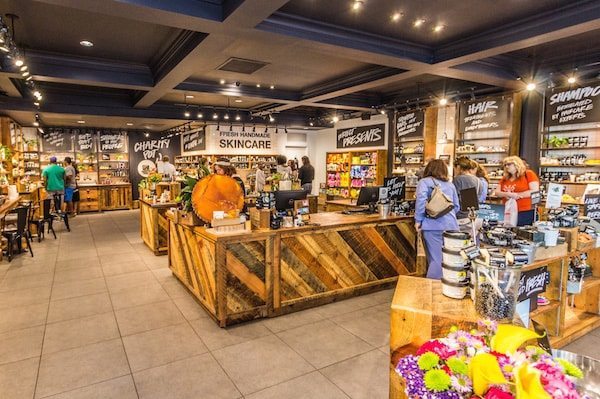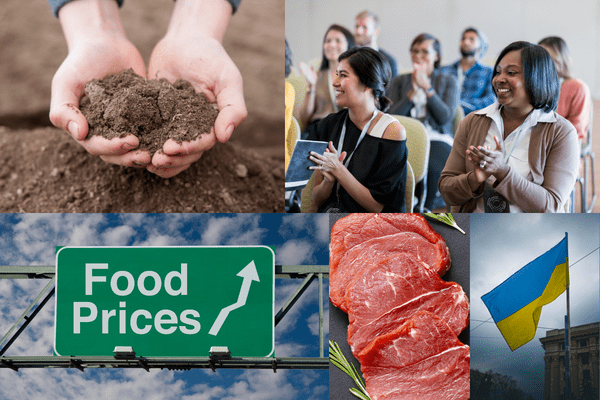Wow, what a year for food and agriculture! For these sectors, 2022 represented uncharted territory, as businesses tried to rebalance and navigate a “new normal” in the wake of a global pandemic and supply chain mayhem.
Meanwhile, new challenges arose—most notably inflation—that had an enormous impact on the entire food value chain. The invasion of Ukraine, widespread labor shortages, and rising input costs also hindered recovery. But great things happened too, such as corporate regenerative agriculture commitments and federal government support for small farmers and meat processors.
As we close out 2022, let’s look back at the biggest events, actions, policies, and trends to impact food and agriculture.
Inflation hits the food industry hard. Consumers faced higher prices at every turn, but perhaps the greatest sticker shock was felt around food. While overall inflation was up 7.1% through November, food got 10.6% more costly, with grocery prices surging 12% and food service menu prices rising 8.5%. All throughout the value chain, businesses swallowed margin to shelter consumers. But with their own input costs skyrocketing, keeping prices low proved difficult.
Avian flu decimates egg supply. When deadly avian flu swept the U.S. in the first half of this year, farmers had to kill millions of laying hens, slashing the nation’s egg supply and driving up prices even more. Through November, eggs remained 49.1% more expensive.
In-person industry events return. Once the Omicron variant ran its course, food and farm folk could finally gather safely again. Industry trade shows, conferences, and other events that had moved virtual or been canceled in 2020 and 2021 returned to in-person formats.
Ukraine invasion rocks commodities. When Russia invaded Ukraine on February 24 and kicked off the still-raging war, it impacted food and ag worldwide. Ukraine was the top global supplier of sunflower oil and, combined with Russia, exported half of all vegetable oils and one-third of the world’s wheat. With the region now war-torn, plus sanctions on Russian imports, supplies shrunk, prices soared, and North American farmers helped fill the void.
Labor shortages—and costs—worsen. Food and ag businesses struggled to maintain employees in 2022, forcing many to offer higher-than-ever wages, spiking their labor costs. Manufacturers increasingly turned to automation, while farming leaders pushed for Senate passage of the Farm Worker Modernization Act, which would allow them to hire H-2A visa workers.
Drought batters Western U.S. The multiyear extreme drought besieging farmers and ranchers out West intensified in 2022, hindering production, drying up water supplies, and further raising food prices.
ESG goes viral. While not new for 2022, environmental, social, and governance (ESG) efforts moved decidedly more mainstream. Even more food and farm businesses committed to thwarting climate change, protecting human rights, and uplifting employees and partners, while investors prioritized ESG metrics.
Biden pledges $1 billion to expand independent meat processing. In January, the President announced his Action Plan for a Fairer, More Competitive, and More Resilient Meat and Poultry Supply Chain to bust Big Meat’s control over the industry. Along with expanding independent processing capacity, the plan tightens labeling rules, boosts industry transparency, and protects workers.
Congress, USDA take on consolidation. To combat the devastating impacts of consolidation on small farms and food companies, U.S. Senators introduced the Food and Agribusiness Merger Moratorium and Antitrust Review Act of 2022 in May. In September, USDA launched two new efforts to support fair and competitive meat and poultry markets.
Food and ag take center stage at COP27. When world leaders met in Egypt for the 2022 United Nations Climate Conference, sustainable food systems received more attention than in years past. A deal was reached to integrate agriculture in the UN’s climate action body, although critics say food waste, nutrition, and resilient supply chains were not sufficiently addressed.
USDA launches Partnerships for Climate-Smart Commodities. Throughout 2022, USDA dedicated over $3.1 billion to support climate-smart farmers, ranchers, and forest landowners. To date, the program is financing 141 pilot projects that expand market opportunities, sequester carbon, advance agroforestry, uplift rural communities, and more.
Struggling farmers score debt relief. In October, the federal government increased debt relief through the Inflation Reduction Act to $1.3 billion, helping a total of 36,000 farmers who’ve fallen behind on loan payments or face foreclosure.
USDA debuts Organic Transition Initiative. Citing the fact that organic farm transition has dropped 70% since 2008, the agency committed $300 million to organic technical assistance, farmer-to-farmer mentoring, market development, and crop insurance aid.
E-commerce cools, value channels surge. After skyrocketing during COVID, online grocery sales simmered in 2022, down 10% in November from one year prior. Meanwhile, with inflation raging, Costco and other club stores reported upticks in traffic and memberships, and dollar stores and convenience stores bolstered their food offerings and snagged more sales.
Big Food invests more in regenerative ag. Corporate food giants like General Mills, Unilever, and even Walmart have made hefty commitments to regenerative ag in recent years, which many believe is necessary to scale up these systems. Prior to COP27, a consortium of 12 companies, including Mars, PepsiCo, and McDonald’s, announced a plan to advance regenerative into the predominant agricultural system worldwide.
Albertsons, Kroger plan merger. In October, the supermarket giants announced a definitive merger agreement worth $26.4 billion, although attorneys general from Colorado and Washington are trying to block the deal. While the merger could expand some food brands’ reach, critics fear fewer opportunities for emerging brands and higher prices for shoppers.
And now, our roundup of the best food and beverage finance news, events and resources from around the web…

Business Model Insights
- Put a co-packer on your priority list (Food & Beverage Insider)
Finding the right co-manufacturer can be a frustrating process. Experts offer guidance on the importance of funding, having a roll-out plan, and knowing what’s nonnegotiable. - How Food Processors Are Cleaning Up Allergens in their Facilities (Food Processing)
- The State of a ‘Normal’ Supply Chain (Food Logistics)

Raising Capital
- New Food Order: We’re beginning a food revolution (New Hope Network)
There’s a huge gap between how planet-friendly is grown and bankrolled—which is why food entrepreneur Sam Kass, senior policy advisor for nutrition in the Obama administration, switched his focus to venture capital. - Securing capital in 2023: How to survive and maybe even thrive (New Hope Network)
- Worried About Raising Capital in a Recession? (Entrepreneur)

CPG/National Brands
- Applegate goes all in for regenerative agriculture with a hot dog (New Hope Network)
The brand that brought antibiotic-free deli meat to the market 30 years ago has produced the first hot dog to earn Land to Market verification. - 2023 Marketing and SEO Trends Your Brand Needs to Succeed (WholeFoods Magazine)
- Innovative beverage formulation: Complications and considerations (Food & Beverage Insider)

Market Trends
- Emerging flavor trends cater to comfort, nostalgia & whimsy (FoodNavigator-USA)
The stressful combo of pandemic lockdowns plus runaway inflation has consumers looking for comfort and escapism from foods and beverages, which is driving demand for new flavor combinations. - Attention-grabbing Viva Magenta to brighten up F&B in 2023 (Food Ingredients First)
- Once a ‘sleepy category,’ the pretzel grabs its fill of the $106B snacking space (Food Dive)

Farming and AgTech
- Produce Traceability Software: A Secret to Food Safety? (Food Logistics)
Why growers and distributors looking to modernize and reinforce PTI standards for food safety should leverage new developments in produce traceability software. - In ‘Raw Deal,’ A Reporter Reveals the Dirty Underbelly of the Meat Industry (Civil Eats)
- Emissions: Nestlé and Fonterra to trial net-zero dairy farm (FoodNavigator-USA)

Deals/M&A
- Precision pollination startup BeeHero nets $42M with backing from General Mills (Food Dive)
Using data analytics and artificial intelligence, BeeHero helps beekeepers and farmers monitor hives and track crop development remotely, informing decision-making to increase yields. - Climate investments a bright spot in cloudy funding climate (Nutrition Capital Network)
- MALK Organics Closes $9 Million Series B to Grow Premium Plant Milk With ‘A Significant Upward Trajectory’ (Forbes)

Industry Events
Virtual events:
- FFI MVP Series Workshop: Financial & Accounting Processes: 1/15
- FFI Level 2 Consultant Training: 1/18
- FFI Immersion Training: Farm Financial Management Boot Camp: 1/24–1/25, 2/14–2/15
In-person events:
- Michigan Organic Food and Farm Alliance Organic Intensives: 1/7 in East Lansing, MI
- The Winter Fancy Food Show: 1/15–1/17 in Las Vegas, NV
- Wisconsin Farmers Union 2023 Lobby Day: 1/18 in Madison, WI
- International Production & Processing Expo: 1/24–1/26 in Atlanta, GA
- Sustainable Foods Summit North America: 1/25–1/26 in San Francisco, CA
- Global Organic Produce Expo: 1/30–2/2 in Hollywood, FL
- The North American Association of Food Equipment Manufacturers Show: 2/1–2/3 in Orlando, FL
- Organic Vegetable Production Conference: 2/3–2/4 in Madison, WI
- UNFI Natural and Conventional Spring and Summer Show: 2/7–2/9 in Orlando, FL
- World Ag Expo: 2/14–2/16 in Tulare, CA
- National Farm Machinery Show: 2/15–2/18 in Louisville, KY
- Marbleseed 34th Annual Organic Farming Conference: 2/23–2/25 in La Crosse, WI
- American Frozen Food Institute AFFI-CON: 2/25–2/28 in San Diego, CA
- Refrigerated Foods Association Annual Conference & Exhibition: 2/26–3/1 in Kiawah Island, SC
- Sierra Harvest Sustainable Food & Farm Conference: 3/3–3/4 in Grass Valley, CA
- International Restaurant & Foodservice Show of New York: 3/5–3/7 in New York, NY
- Annual Meat Conference: 3/6–3/8 in Dallas, TX
- Natural Products Expo West: 3/7–3/11 in Anaheim, CA
- Seafood Expo North America Seafood Marketplace Show: 3/12–3/14 in Boston, MA
- World Agri-Tech Innovation Summit: 3/14–3/15 in San Francisco, CA
- Soil Health Academy School: Regenerative Farming and Ranching: 3/14–3/16 in Chico, CA
- SNAXPO23: 3/19–3/21 in Orlando, FL
